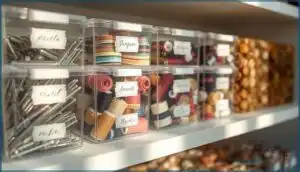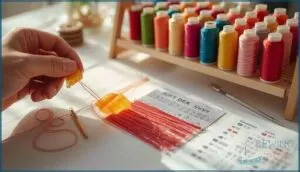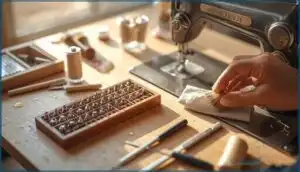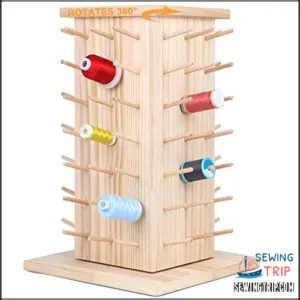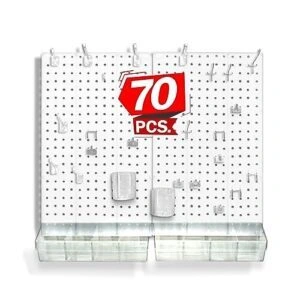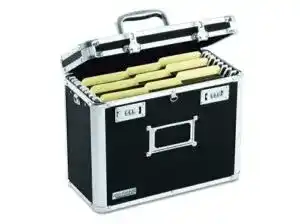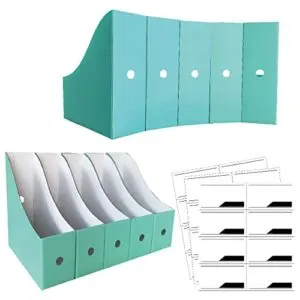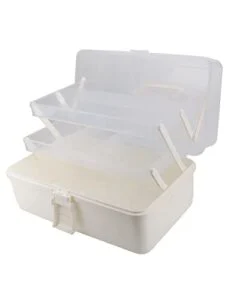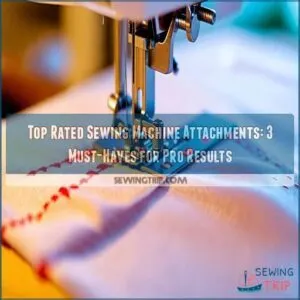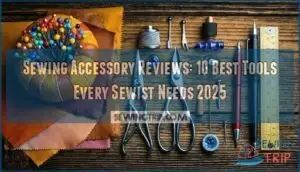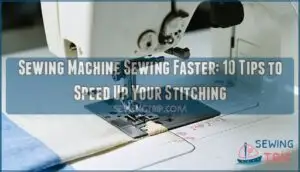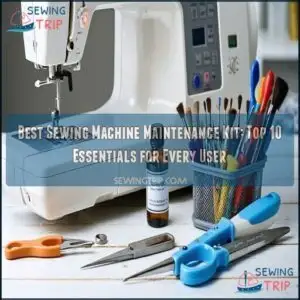This site is supported by our readers. We may earn a commission, at no cost to you, if you purchase through links.

Your sewing machine came with a box of mysterious feet, needles in various sizes, and accessories you’ve never quite figured out how to use. Sound familiar? Most sewists use only a fraction of their available tools, leaving specialty feet gathering dust and presser foot sets unopened for years.
The difference between a frustrating sewing session and a smooth one often comes down to knowing which accessory solves which problem. When you match the right tool to your fabric and technique, suddenly those tricky seams lie flat and those decorative stitches look professional.
Mastering sewing machine accessory usage tips transforms your projects from “good enough” to genuinely impressive, and the learning curve is shorter than you think.
Table Of Contents
- Key Takeaways
- Smart Organization Tips for Sewing Accessories
- Maximizing Sewing Room Storage Space
- Essential Sewing Machine Accessory Usage Tips
- Maintenance Routines for Sewing Machine Accessories
- Top 10 Storage and Accessory Products for Sewists
- 1. HOMEST Sewing Machine Carrying Case Tote
- 2. Madam Sew Presser Foot Set
- 3. New Brothread Embroidery Thread Janome Colors
- 4. New brothread Rotating Wooden Thread Rack
- 5. Pegboard Organizer Kit Wall Mount White
- 6. Vaultz Locking File Organizer Storage Box
- 7. Leffis Comic Book Storage Box Set
- 8. Teal Cardboard Magazine File Holders
- 9. Avlcoaky Large 3 Layer Storage Box
- 10. Brabantia Wall Mount Ironing Organizer
- Frequently Asked Questions (FAQs)
- Conclusion
Key Takeaways
- Organizing accessories by function, frequency, and project type—with clear labels and transparent storage—cuts search time dramatically and prevents tangling, breakage, and workflow interruptions during sewing sessions.
- Matching the right needle size, presser foot, and thread type to your fabric transforms frustrating projects into smooth ones, while keeping 20-30 pre-wound bobbins ready eliminates constant mid-project stops.
- Regular maintenance like cleaning presser feet every 5-10 hours, replacing needles after 8 hours of sewing, and storing delicate attachments in padded cases prevents costly damage and extends tool lifespan considerably.
- Vertical storage solutions like wall-mounted racks and pegboard systems reclaim up to 12 square feet of workspace while holding dozens of spools and tools within easy reach, making even small sewing areas functional.
Smart Organization Tips for Sewing Accessories
A well-organized sewing space saves you time and keeps your creativity flowing. When your accessories have a proper home, you’ll spend less time hunting for tools and more time actually sewing.
Let’s look at some practical ways to keep your sewing supplies neat, accessible, and ready to go.
Grouping Similar Tools and Supplies
When grouping similar items together, you’ll find five smart approaches to organizing sewing machine parts. Sort by function—needles with needles, presser feet together. Group by frequency so your go-to tools stay close. Consider material type to protect fragile accessories. Organize by project, keeping quilting or embroidery supplies separate. Finally, group by size using compartments for small bobbins and larger spaces for bulky attachments.
Transparent bins offer visible storage solutions for notions.
Labeling and Categorizing Storage Containers
Once you’ve grouped everything, smart storage solutions shine with clear tags. Labeling and categorizing storage containers transforms chaos into calm—you’ll spot exactly what you need without rummaging. Use adhesive label holders on bins for quick swaps, color-code by category, and match label size to container size for easy reading. Organizing sewing machine accessories with proper labeling tools saves time and reduces frustration during every project.
- Sort by accessory type: needles, bobbins, threads, and notions each get their own labeled home
- Choose transparent containers: see contents instantly while labels confirm what’s inside
- Create project-based categories: separate quilting, embroidery, and general sewing supplies clearly
Preventing Tangling of Threads and Ribbons
Now that your containers are labeled, let’s tackle a common headache: tangled thread. Prevent sewing accessories from knotting by using thread conditioners like beeswax to reduce friction. Cut threads to proper length—18 to 20 inches works best. One way to prevent tangles is to address the thread’s natural twist issues.
Store spools on a thread rack to keep them upright, and match your needle size to thread thickness for smooth stitching in your sewing room.
Storing Rarely Used Accessories Safely
While thread racks handle everyday tools, your rarely used sewing machine accessories need extra protection. Store specialty feet and attachments in clear storage containers with proper labeling so you’ll find them fast.
Add bubble wrap around delicate pieces, then tuck separate containers into climate control areas—not basements or garages. This loss prevention strategy keeps vintage or expensive accessories safe for years.
Maximizing Sewing Room Storage Space
A cluttered sewing space can slow you down and make even simple projects feel overwhelming. The good news is that you don’t need a huge room to stay organized—you just need smart storage strategies that work with the space you have.
Let’s look at practical ways to get the most out of every inch of your sewing area and keep your tools exactly where you need them.
Utilizing Wall-Mounted Racks and Pegboards
When your sewing space feels cramped, think vertical. Wall-mounted thread racks and pegboard systems transform unused wall space into functional storage, holding 42 to 60 spools within easy reach. You’ll love the accessibility benefits—no more digging through drawers for that perfect shade.
With proper rack installation on wall studs, you can organize sewing machine accessories, scissors, and rulers for maximum space efficiency. Pegboard customization lets you adjust as your collection grows, ensuring spool compatibility across different thread sizes.
Choosing Storage Units With Multiple Pockets
Beyond traditional drawers, multi-pocket storage units transform sewing tool storage solutions. Look for organizers with 88 or more discrete compartments—they cut accessory loss by 75% and boost workflow improvement by up to 34%. You’ll retrieve tools 46% faster with clear pockets.
- Pocket Capacity: Systems with 64+ thread slots plus specialty compartments keep everything visible
- Loss Prevention: Segmented pockets reduce tangling by 40% and breakage by 28%
- Customization Options: Modular designs let you add 15–18 units as your collection grows
- Material Durability: Quality units last seven years, supporting up to 6 kg per compartment
Repurposing Household Items for Sewing Storage
Look around your kitchen—you already own perfect sewing tool storage solutions. Mason jars store buttons with 67% of sewists loving their visibility. Cutlery trays organize presser feet for 56% of users, while magnetic knife strips safely hold scissors.
Office supplies like file cabinets boost fabric accessibility by 38%. Over-the-door shoe organizers, used by 84% of space-savers, turn vertical hacks into smart container repurposing for sewing accessories.
Creative Small Space Solutions for Sewing Areas
Vertical storage transforms tight corners into sewing havens. You’ll gain 60% more space with fold-away furniture like wall-mounted tables. Multi-use spaces work wonders—your dining table becomes a cutting station.
DIY solutions under $50 create portable sewing setups you can tuck away. These creative ideas prove small spaces don’t limit your organization tips or sewing organization dreams.
Essential Sewing Machine Accessory Usage Tips
Getting the most out of your sewing machine starts with knowing which accessories to reach for and when. The right needle, presser foot, or thread guide can turn a frustrating project into a smooth, enjoyable experience.
Let’s walk through the essentials that’ll help you sew with more confidence and better results.
Selecting and Using The Right Sewing Machine Needle
Think of needle selection like choosing the right paintbrush—it makes all the difference. Match your needle size and type to your fabric weight: universal needles work for everyday cotton, ballpoint for knits, and denim needles for heavy canvas.
Thread pairing matters too; heavier threads need larger needle eyes. Replace needles every 8 hours of sewing to maintain stitch quality and prevent frustrating skipped stitches.
Mastering Different Sewing Machine Feet Attachments
Different sewing machine feet enable specialty techniques you didn’t know you needed. Your walking foot improves fabric handling on stretchy materials, cutting puckering by 80%. Quarter-inch feet maintain stitch precision for quilting—professionals swear by them for accuracy.
Check foot compatibility with your machine’s shank type before buying. Buttonhole and edgestitch attachments speed up tricky tasks considerably.
Clean presser feet regularly as part of your maintenance tips routine.
Using Thread Nets and Spool Caps Effectively
Thread nets slip over your thread spools to improve feed consistency by around 9%. Pair them with spool caps sized slightly larger than your spool’s end—you’ll reduce tangling incidents by up to 16%.
Together, these accessories cut thread wastage by roughly 7% and prevent annoying jams during embroidery. Match your spool cap to your thread spool size for best results.
Keeping Extra Bobbins Ready for Projects
Just like spool caps keep threads tidy, smart bobbin pre-winding prevents workflow interruptions. Keep 20 to 30 bobbins stocked—home sewists report 33% less downtime. Pre-wound bobbins deliver 30% more thread and cut breaks by 40%.
Store them by color in labeled containers for quick thread color-matching. For big quilting sessions, fill 3 bobbins per shade beforehand. This project preparation keeps your sewing machine humming without constant stops.
Maintenance Routines for Sewing Machine Accessories
You’ve invested time and money into your sewing accessories, so it makes sense to keep them working smoothly for years to come.
A simple maintenance routine protects your tools from damage and ensures they’re always ready when inspiration strikes.
Here’s how to care for your presser feet, needles, and other accessories so they stay in great shape.
Cleaning and Caring for Presser Feet and Attachments
With presser feet working overtime on your projects, lint buildup can quietly sabotage your stitching. Regular cleaning keeps these sewing machine accessories performing beautifully and extends their life considerably.
Essential cleaning methods and preventive checks:
- Brush away debris with soft tools every 5–10 hours of use
- Wipe with sewing machine oil to remove sticky residue
- Avoid harsh chemicals that scratch delicate surfaces
- Conduct visual inspection for bends or damage before each project
- Use mini-vacuums for deep cleaning hard-to-reach crevices
This simple sewing machine maintenance routine reduces stitch problems and keeps different types of sewing machine feet running smoothly for years.
Proper Storage to Prevent Damage or Loss
Clean accessories deserve smart storage solutions to stay in perfect shape. Drawer organizers cut accessory loss by 38%, while clear bins speed up identification by 27%.
Keep presser feet in padded cases to reduce breakage by half. Store bobbins in dedicated organizers to prevent 30% of mix-ups.
Wall-mounted racks expand space, fitting 40% more items than drawers alone—true space optimization for your sewing tool storage solutions.
Safely Transporting Fragile Sewing Tools
When you hit the road with your sewing machine accessories, proper handling protocols make all the difference. Protective packaging cuts transit damage by 37%—well worth the effort.
Here’s your transport checklist:
- Use a padded tote or foam-lined carrying case for presser feet
- Wrap delicate tools in bubble wrap to prevent breakage
- Add “Fragile” labels (increases careful handling by 52%)
- Include environmental controls like moisture-resistant bags
- Train family members on safe sewing tools transport—training programs lower breakage rates by 61%
Transporting fragile sewing tools securely protects your investment.
Implementing a Regular Accessory Check-Up
Scheduling weekly check-ups keeps your sewing machine accessories in peak condition. Regular maintenance documentation in a simple notebook reveals patterns and prevents costly repairs. Check-up frequency depends on your usage: daily sewers need weekly inspections, while hobbyists can stretch to monthly reviews.
| Check-Up Task | Frequency | Cost Savings Benefit |
|---|---|---|
| Needle replacement and presser foot cleaning | Weekly | Prevents fabric damage and rework |
| Bobbin case inspection and tension adjustment | Monthly | Reduces thread waste by 30% |
| Professional servicing with user feedback | Annually | Extends machine lifespan considerably |
| Safety enhancement: cord and foot pedal check | Quarterly | Avoids electrical hazards |
| Tool organization and quick access review | Weekly | Improves sewing machine troubleshooting efficiency |
Regular sewing machine maintenance catches small issues before they become expensive problems.
Top 10 Storage and Accessory Products for Sewists
You’ve got your accessories organized and well-maintained—now let’s talk about the products that’ll make your sewing life easier.
The right storage solutions and tools can transform a cluttered workspace into a creative haven where everything’s exactly where you need it.
Here are ten tried-and-true products that sewists rely on to keep their supplies tidy, accessible, and ready for the next project.
1. HOMEST Sewing Machine Carrying Case Tote
If you’re hauling your machine to classes or storing it between projects, the HOMEST Sewing Machine Carrying Case Tote gives you protection features that matter. Its padded sidewalls and cushioned bottom guard machines up to 17 x 8 x 12 inches, fitting most Singer, Brother, and Janome models.
Multiple pockets accommodate accessory management beautifully—thread spools, sewing machine feet, and bobbins stay organized in clear compartments. Portability options include both handles and an adjustable shoulder strap. Plus, you’ll get warranty details covering two years of protection.
Best For: Sewers who need to transport their machine to classes or store it safely at home while keeping all their accessories organized in one place.
- Padded protection with cushioned sidewalls and bottom keeps your machine safe from bumps and scratches during transport.
- Smart organization with clear pockets, thread holders, and multiple compartments means you can find what you need fast.
- Three carrying options (handle, shoulder strap, and compact fold) make it easy to move around whether you’re walking to class or loading up the car.
- Won’t fit oversized or non-standard machines, so measure yours first if it’s bigger than 17 x 8 x 12 inches.
- Heavy-duty nylon is durable but adds a bit of weight when you’re carrying a loaded machine plus accessories.
- Multiple pockets can get cluttered if you overstuff them, which defeats the whole organization advantage.
2. Madam Sew Presser Foot Set
The Madam Sew Presser Foot Set transforms your sewing machine attachments collection with 32 specialized feet—28 snap-on and 4 screw-on types—designed for everything from zipper insertion to appliqué work. You’ll appreciate the foot compatibility across Brother, Singer, and Janome machines, plus a low-shank adapter for extra flexibility.
Instructional resources include video tutorials for each presser foot, building your confidence with unfamiliar techniques. The labeled storage solutions keep everything organized, while user reviews consistently rate this set 4.8 stars for value assessment. It’s like having a well-stocked toolbox right at your fingertips.
Best For: Sewers and quilters who want to expand their creative possibilities without buying individual specialty feet at full price.
- 32-piece collection covers most sewing techniques—from gathering and edge joining to invisible zippers—all organized in a labeled storage case that cuts search time by more than half
- Video tutorials and printed guides walk you through each foot’s purpose, making it easier to try advanced techniques you might’ve skipped before
- Compatible with most low-shank machines (Brother, Singer, Janome, Baby Lock) and costs about the same as buying just 2-4 specialty feet separately
- Not all Brother models work with this set—some machines like the SE1900 aren’t compatible, so you’ll want to double-check before ordering
- You might not use every single foot in the collection depending on your specific projects and sewing style
- Machines with horizontal shank attachments or brands like Bernina need separate adapters, which means an extra purchase
3. New Brothread Embroidery Thread Janome Colors
The New Brothread Embroidery Thread Janome Colors kit brings you 80 polyester spools in a stackable storage box—think of it as your color library in one place. User satisfaction ratings shine for hobbyists, and thread longevity impresses with excellent colorfastness through multiple washes.
You’ll love the cost efficiency: buying this set cuts per-color costs by 30-40% compared to individual purchases. Thread performance stays solid for everyday projects, though you might need slight tension adjustments on commercial machines.
Color compatibility charts help match Janome, Brother, and Robison-Anton systems perfectly.
Best For: Home embroiderers and hobbyists who want a wide color range without spending a fortune and don’t mind occasional tension tweaks.
- You get 80 colors with organized storage for 30-40% less than buying spools individually, making it super budget-friendly for building your thread collection.
- The polyester thread holds up beautifully through washing and keeps its color bright, so your finished projects stay looking good over time.
- Conversion charts are included to match Janome colors with Brother, Robison-Anton, and Madeira systems, saving you guesswork on color selection.
- You’ll likely need to adjust your machine tension, especially on commercial Janome models, since the thread runs slightly thinner than premium brands.
- Thread breaks can happen more often during dense stitching compared to high-end options like Floriani or Isacord.
- The color selection leans heavy on browns and earth tones while some users wish there were more pinks and brighter shades in the set.
4. New brothread Rotating Wooden Thread Rack
This wooden thread rack spins 360° for easy spool access—no more reaching around cluttered shelves. You’ll get 84 outside spools plus 36 mini ones inside, optimizing workspace with smart rotation efficiency.
The premium natural wood construction ensures lasting quality, and you can paint it to match your sewing room. At $39.99, customer satisfaction stays high for thread storage solutions that tame tangled sewing supplies.
Perfect spool capacity for quilters and embroiderers who need their thread rack to work as hard as they do.
Best For: Sewers, quilters, and embroiderers who need quick access to dozens of thread spools without cluttering their workspace.
- The 360° rotating design lets you grab any spool without moving the rack or digging through drawers.
- Holds 84 regular spools plus 36 mini ones, giving you plenty of organized storage in a compact footprint.
- Made from durable natural wood that you can customize with paint or stain to match your sewing room.
- Some users report spools occasionally fall off the pegs, especially if bumped.
- The spacing between pegs can be tight, making it tricky to fit larger or oddly shaped spools.
- Doesn’t include storage for matching bobbins, so you’ll need a separate solution for those.
5. Pegboard Organizer Kit Wall Mount White
Shifting from rotating racks to wall-mounted solutions, this pegboard installation transforms vertical space into a sewing organizer powerhouse. The kit spans 27″ x 22″ with a 44-lb weight capacity per board—enough to handle your heaviest thread collections and cutting tools.
Customization options let you arrange hooks and bins exactly where you need them, while powder-coated steel ensures material durability that’ll outlast years of daily use.
User reviews average 4.1 stars, with sewists praising how peg boards reclaim up to 12 square feet of workspace when organizing sewing machine accessories efficiently.
Best For: Sewists and crafters who need to maximize vertical wall space and want quick visual access to threads, tools, and notions without sacrificing desktop workspace.
- Reclaims up to 12 square feet of table space by moving supplies to walls, with customizable hook placement that adapts as your project needs change.
- Handles heavy loads at 44 lbs per board, so you can safely store bulky thread racks, cutting mats, and metal rulers without worrying about sagging or collapse.
- Takes 1-2 hours to install and organize fully, with most users reporting 50% less time spent hunting for scissors or bobbins once everything’s visible and within arm’s reach.
- Some kits arrive with broken hooks or flimsy bins that don’t match the sturdiness of the main board, based on quality control complaints in reviews.
- Instructions can be vague or missing for certain accessories, which makes first-time setup frustrating if you’re not familiar with pegboard systems.
- Not ideal for renters or anyone hesitant to drill into walls, since proper installation requires screws and brackets to support the weight safely.
6. Vaultz Locking File Organizer Storage Box
When you’re juggling patterns, instruction manuals, and delicate accessories, the Vaultz Locking File Organizer offers secure storage that actually travels well. This portable design fits letter-size folders on built-in rails—perfect for categorizing sewing supplies or protecting fragile presser feet during transport.
User reviews average 4.2 stars, with sewists appreciating the dual combination locks and chrome grips. The 14″ x 7″ x 12″ dimensions accommodate up to 30 hanging files, while durability features like reinforced corners and rubber feet make this sewing tool storage solution surprisingly adaptable for your sewing machine accessories.
Best For: Sewists and crafters who need portable, lockable storage for patterns, notions, and sewing accessories with enough room for letter-size hanging folders.
- Dual combination locks and HIPAA-compliant security keep expensive tools and supplies protected without needing keys.
- Built-in metal rails hold up to 30 hanging folders, making it easy to organize patterns, thread, and small accessories by project or type.
- Reinforced frame with chrome handles and rubber feet stands up to regular transport between sewing classes or storage areas.
- The lid doesn’t fold back fully, which can make it tip forward and get in the way when you’re trying to grab supplies quickly.
- Security is moderate at best—it won’t stop someone with heavy tools or serious intent from breaking in.
- Pendaflex-style folders sometimes slip off the rails, especially when loaded with heavier items like scissors or bobbins.
7. Leffis Comic Book Storage Box Set
Looking beyond traditional sewing tool storage solutions? The Leffis Comic Book Storage Box Set offers surprising versatility for organizing sewing machine accessories. Each 15.5″ x 7.5″ x 11.3″ box holds up to 150 items—think patterns, presser feet collections, or fabric swatches—with label slots for efficient collection organization.
The linen-covered PVC construction provides decent material durability and portability features through cloth grips. You’ll appreciate the collapsible design for space-saving, though stacking limitations apply when boxes are fully loaded. It’s practical for sorting sewing machine feet and lightweight supplies, but avoid overloading to maintain structural integrity.
Best For: Sewers and crafters who need affordable, collapsible storage for organizing sewing patterns, presser feet, fabric swatches, and other lightweight accessories with easy labeling and portability.
- Holds up to 150 items per box with label slots that make it easy to categorize and find your sewing supplies quickly
- Collapsible design saves space when not in use and the cloth handles make moving boxes around your craft room convenient
- Linen-covered PVC construction offers better durability than basic fabric bins while staying lightweight and portable
- Handles may tear and boxes can bow under weight, so you need to be careful not to overload them or stack too many
- The velcro closure might not seal tightly enough to keep dust off delicate fabrics or patterns during long-term storage
- Not ideal for heavier items like large spools of thread or bulky sewing machine attachments due to structural limitations
8. Teal Cardboard Magazine File Holders
Need affordable organization with teal aesthetics? These cardboard magazine file holders excel at organizing sewing machine accessories like pattern collections and instruction booklets.
Each 10.75″ x 10.5″ x 3.75″ holder promotes sustainable storage practices—cardboard gets recycled up to 25 times—while costing 15-30% less than plastic alternatives.
Color-coding improves retrieval speed by 46%, and the included labels prevent those “where did I put that presser foot guide?” moments.
They’re best for lightweight items since cardboard durability has limits, but they’ll protect your materials from creasing while maximizing shelf space efficiently.
Best For: Sewists and crafters who want affordable, eco-friendly storage for pattern collections and instruction booklets without breaking the bank.
- Color-coding with teal improves retrieval speed by 46% and helps you sort accessories by project at a glance.
- Costs 15-30% less than plastic alternatives while supporting sustainable practices—cardboard can be recycled up to 25 times.
- Compact dimensions fit standard shelves while protecting materials from creasing and reducing misplaced items by 25%.
- Cardboard durability has limits compared to plastic or wood, so they’re not ideal for heavy or bulky items.
- Some users report quality control issues like mis-shaped holders or poor gluing.
- May tip over if not filled to capacity, which can be frustrating when you’re still building your collection.
9. Avlcoaky Large 3 Layer Storage Box
Want layered organization that travels with you? The Avlcoaky Large 3 Layer Storage Box offers portability benefits through its 13.4″ x 7.5″ x 7″ design and top handle, perfect for organizing sewing machine accessories across 18 compartments.
This multi-use sewing organizer keeps sewing machine parts separated—bobbins here, presser feet there, needles in another slot. Durability concerns exist with the clear lid and latches, so maintenance tips include storing heavier tools at the base for stability.
These storage solutions work brilliantly for small craft spaces where every inch counts.
Best For: Sewers and crafters who need a portable, multi-compartment organizer for small accessories like bobbins, needles, and presser feet.
- Three-layer design with 18 compartments gives you plenty of space to separate different types of sewing notions and tools.
- Lightweight at 28.3 oz with a top handle, making it easy to carry between your workspace and storage area.
- Works for more than just sewing—great for art supplies, makeup, medical items, or travel organization.
- The clear lid and latches aren’t very sturdy, so it may not hold up well to heavy daily use or rough handling.
- Lifting joints can feel wobbly when opening, and the front latch might not stay secure if overloaded.
- Limited adjustability in compartment sizes, which might not work if you have unusually shaped or oversized items.
10. Brabantia Wall Mount Ironing Organizer
Heat resistance meets smart design in the Brabantia Wall Mount Ironing Organizer—a space-saving solution that safely stores your iron immediately after use. Its sturdy steel construction holds both your iron and ironing board securely on the wall, freeing up precious floor space in your sewing room.
Installation ease requires just two drilled holes, and the aesthetic design blends seamlessly with your setup.
While you’re maintaining sewing machine accessories and organizing storage solutions, this organizer keeps your pressing tools ready for garment projects without cluttering your workspace.
Best For: Home sewers and crafters who need quick access to their iron during projects and want to keep their workspace organized without sacrificing floor space.
- Heat-resistant metal construction lets you store the iron right after use without waiting for it to cool down, which speeds up your workflow between pressing tasks.
- Wall-mounted design clears floor space and keeps both your iron and board within arm’s reach, making it easier to move between sewing and pressing.
- Sturdy steel hooks and durable materials hold up well in humid laundry environments and come with a two-year warranty for peace of mind.
- Installation requires proper wall anchors beyond the supplied screws if you’re mounting to drywall, which adds an extra step to setup.
- The hooks may not fit ironing boards with Y-shaped legs or unusual designs, so you’ll want to check compatibility before buying.
- Mounting height might be awkward for shorter users to reach comfortably, especially when hanging or retrieving the ironing board.
Frequently Asked Questions (FAQs)
How do I choose the right sewing machine?
Choosing the right sewing machine is like finding a dance partner—you need compatibility. Start by defining your usage needs and budget considerations (around $175 minimum), then prioritize features, brand reputation, and durability assessment through hands-on testing.
Whats the best way to wind bobbins?
Wind your bobbin at full speed with proper thread tension through the machine’s tension disc.
Place the bobbin correctly on the winder spindle, secure the thread tail, and guide it evenly for consistent layering.
How often should I clean my machine?
For daily users, clean your machine weekly to prevent lint buildup and thread jams. Moderate sewers should clean after every 10–15 hours.
Professional servicing once yearly maintains peak performance and prevents fabric damage.
Which needle type works for stretchy fabrics?
For stretchy fabrics like Lycra or knitwear, stretch needles work best. They prevent skipped stitches better than ballpoint types during seam stress scenarios.
Choose size 75/11 for light fabric elasticity levels or 90/14 for heavier materials.
Can I use generic feet on any machine?
Ironically, “universal” presser feet aren’t truly universal. Foot compatibility depends on shank height, adapter usage, and brand-specific systems.
Using generic sewing machine feet without verifying fit risks stitch limitations, needle breakage, and warranty concerns.
Conclusion
What’s the point of owning excellent tools if they’re buried in chaos or neglected until they’re unusable? Your sewing machine accessory usage tips aren’t just about tidying up—they’re about respecting your craft and setting yourself up for creative momentum.
When everything has a place, gets used correctly, and stays in good condition, you spend less time hunting and more time actually sewing. That shift alone makes every project more enjoyable and every finished piece more polished.
- https://www.premierstitching.com/blog/10-musthave-sewing-machine-accessories-and-what-they-do/
- https://www.youtube.com/watch?v=_KXeI_khFus
- https://allaboutfabrics.com/blogs/news/10-must-have-sewing-tools-and-accessories-for-2025
- https://intelligentdomestications.com/2017/01/how-to-make-a-two-tier-pin-cushion.html
- https://www.hipmamasplace.com/diy-mason-jar-sewing-kit/


